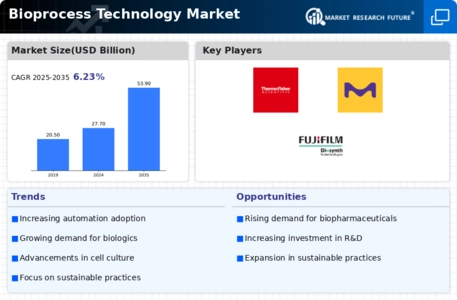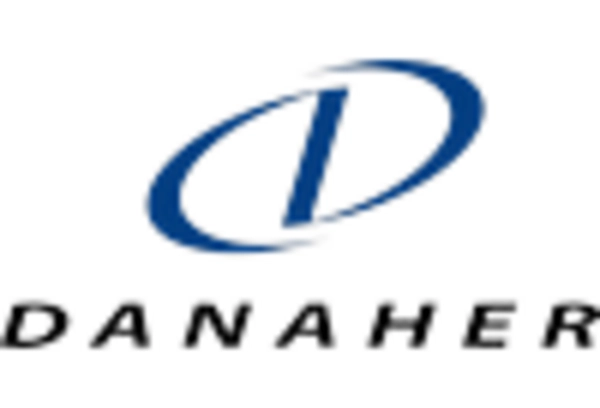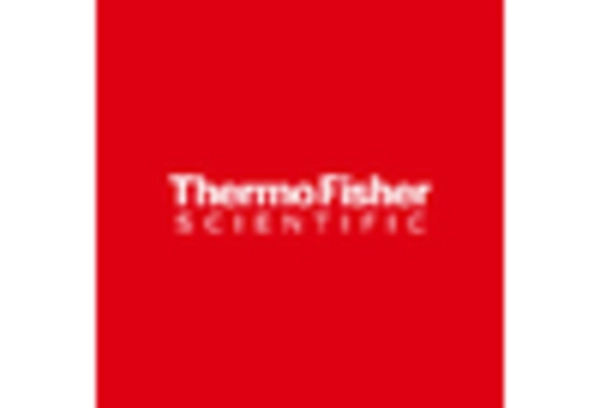-
EXECUTIVE SUMMARY
-
Market Overview
-
Key Findings
-
Market Segmentation
-
Competitive Landscape
-
Challenges and Opportunities
-
Future Outlook
-
MARKET INTRODUCTION
-
Definition
-
Scope of the study
- Research Objective
- Assumption
- Limitations
-
RESEARCH METHODOLOGY
-
Overview
-
Data Mining
-
Secondary Research
-
Primary Research
- Primary Interviews and Information Gathering Process
- Breakdown of Primary Respondents
-
Forecasting Model
-
Market Size Estimation
- Bottom-Up Approach
- Top-Down Approach
-
Data Triangulation
-
Validation
-
MARKET DYNAMICS
-
Overview
-
Drivers
-
Restraints
-
Opportunities
-
MARKET FACTOR ANALYSIS
-
Value chain Analysis
-
Porter's Five Forces Analysis
- Bargaining Power of Suppliers
- Bargaining Power of Buyers
- Threat of New Entrants
- Threat of Substitutes
- Intensity of Rivalry
-
COVID-19 Impact Analysis
- Market Impact Analysis
- Regional Impact
- Opportunity and Threat Analysis
-
BIOPROCESS TECHNOLOGY MARKET, BY APPLICATION (USD BILLION)
-
Monoclonal Antibodies
-
Vaccines
-
Recombinant Proteins
-
Gene Therapy
-
BIOPROCESS TECHNOLOGY MARKET, BY PRODUCT TYPE (USD BILLION)
-
Bioreactors
-
Filtration Systems
-
Separation Systems
-
Cell Culture Systems
-
BIOPROCESS TECHNOLOGY MARKET, BY END USER (USD BILLION)
-
Pharmaceuticals
-
Biotechnology Companies
-
Academic Research Institutions
-
Contract Research Organizations
-
BIOPROCESS TECHNOLOGY MARKET, BY SCALE OF OPERATION (USD BILLION)
-
Laboratory Scale
-
Pilot Scale
-
Industrial Scale
-
BIOPROCESS TECHNOLOGY MARKET, BY REGIONAL (USD BILLION)
-
North America
- US
- Canada
-
Europe
- Germany
- UK
- France
- Russia
- Italy
- Spain
- Rest of Europe
-
APAC
- China
- India
- Japan
- South Korea
- Malaysia
- Thailand
- Indonesia
- Rest of APAC
-
South America
- Brazil
- Mexico
- Argentina
- Rest of South America
-
MEA
- GCC Countries
- South Africa
- Rest of MEA
-
COMPETITIVE LANDSCAPE
-
Overview
-
Competitive Analysis
-
Market share Analysis
-
Major Growth Strategy in the Bioprocess Technology Market
-
Competitive Benchmarking
-
Leading Players in Terms of Number of Developments in the Bioprocess Technology Market
-
Key developments and growth strategies
- New Product Launch/Service Deployment
- Merger & Acquisitions
- Joint Ventures
-
Major Players Financial Matrix
- Sales and Operating Income
- Major Players R&D Expenditure. 2023
-
COMPANY PROFILES
-
Eppendorf AG
- Financial Overview
- Products Offered
- Key Developments
- SWOT Analysis
- Key Strategies
-
GE Healthcare
- Financial Overview
- Products Offered
- Key Developments
- SWOT Analysis
- Key Strategies
-
Becton Dickinson and Company
- Financial Overview
- Products Offered
- Key Developments
- SWOT Analysis
- Key Strategies
-
Agilent Technologies
- Financial Overview
- Products Offered
- Key Developments
- SWOT Analysis
- Key Strategies
-
Parker Hannifin Corporation
- Financial Overview
- Products Offered
- Key Developments
- SWOT Analysis
- Key Strategies
-
Thermo Fisher Scientific
- Financial Overview
- Products Offered
- Key Developments
- SWOT Analysis
- Key Strategies
-
Repligen Corporation
- Financial Overview
- Products Offered
- Key Developments
- SWOT Analysis
- Key Strategies
-
Sartorius AG
- Financial Overview
- Products Offered
- Key Developments
- SWOT Analysis
- Key Strategies
-
Abbott Laboratories
- Financial Overview
- Products Offered
- Key Developments
- SWOT Analysis
- Key Strategies
-
Danaher Corporation
- Financial Overview
- Products Offered
- Key Developments
- SWOT Analysis
- Key Strategies
-
Waters Corporation
- Financial Overview
- Products Offered
- Key Developments
- SWOT Analysis
- Key Strategies
-
Promega Corporation
- Financial Overview
- Products Offered
- Key Developments
- SWOT Analysis
- Key Strategies
-
Lonza Group
- Financial Overview
- Products Offered
- Key Developments
- SWOT Analysis
- Key Strategies
-
Merck KGaA
- Financial Overview
- Products Offered
- Key Developments
- SWOT Analysis
- Key Strategies
-
Fujifilm Diosynth Biotechnologies
- Financial Overview
- Products Offered
- Key Developments
- SWOT Analysis
- Key Strategies
-
APPENDIX
-
References
-
Related Reports
-
LIST OF TABLES
-
LIST OF ASSUMPTIONS
-
NORTH AMERICA BIOPROCESS TECHNOLOGY MARKET SIZE ESTIMATES & FORECAST, BY APPLICATION, 2019-2032 (USD BILLIONS)
-
NORTH AMERICA BIOPROCESS TECHNOLOGY MARKET SIZE ESTIMATES & FORECAST, BY PRODUCT TYPE, 2019-2032 (USD BILLIONS)
-
NORTH AMERICA BIOPROCESS TECHNOLOGY MARKET SIZE ESTIMATES & FORECAST, BY END USER, 2019-2032 (USD BILLIONS)
-
NORTH AMERICA BIOPROCESS TECHNOLOGY MARKET SIZE ESTIMATES & FORECAST, BY SCALE OF OPERATION, 2019-2032 (USD BILLIONS)
-
NORTH AMERICA BIOPROCESS TECHNOLOGY MARKET SIZE ESTIMATES & FORECAST, BY REGIONAL, 2019-2032 (USD BILLIONS)
-
US BIOPROCESS TECHNOLOGY MARKET SIZE ESTIMATES & FORECAST, BY APPLICATION, 2019-2032 (USD BILLIONS)
-
US BIOPROCESS TECHNOLOGY MARKET SIZE ESTIMATES & FORECAST, BY PRODUCT TYPE, 2019-2032 (USD BILLIONS)
-
US BIOPROCESS TECHNOLOGY MARKET SIZE ESTIMATES & FORECAST, BY END USER, 2019-2032 (USD BILLIONS)
-
US BIOPROCESS TECHNOLOGY MARKET SIZE ESTIMATES & FORECAST, BY SCALE OF OPERATION, 2019-2032 (USD BILLIONS)
-
US BIOPROCESS TECHNOLOGY MARKET SIZE ESTIMATES & FORECAST, BY REGIONAL, 2019-2032 (USD BILLIONS)
-
CANADA BIOPROCESS TECHNOLOGY MARKET SIZE ESTIMATES & FORECAST, BY APPLICATION, 2019-2032 (USD BILLIONS)
-
CANADA BIOPROCESS TECHNOLOGY MARKET SIZE ESTIMATES & FORECAST, BY PRODUCT TYPE, 2019-2032 (USD BILLIONS)
-
CANADA BIOPROCESS TECHNOLOGY MARKET SIZE ESTIMATES & FORECAST, BY END USER, 2019-2032 (USD BILLIONS)
-
CANADA BIOPROCESS TECHNOLOGY MARKET SIZE ESTIMATES & FORECAST, BY SCALE OF OPERATION, 2019-2032 (USD BILLIONS)
-
CANADA BIOPROCESS TECHNOLOGY MARKET SIZE ESTIMATES & FORECAST, BY REGIONAL, 2019-2032 (USD BILLIONS)
-
EUROPE BIOPROCESS TECHNOLOGY MARKET SIZE ESTIMATES & FORECAST, BY APPLICATION, 2019-2032 (USD BILLIONS)
-
EUROPE BIOPROCESS TECHNOLOGY MARKET SIZE ESTIMATES & FORECAST, BY PRODUCT TYPE, 2019-2032 (USD BILLIONS)
-
EUROPE BIOPROCESS TECHNOLOGY MARKET SIZE ESTIMATES & FORECAST, BY END USER, 2019-2032 (USD BILLIONS)
-
EUROPE BIOPROCESS TECHNOLOGY MARKET SIZE ESTIMATES & FORECAST, BY SCALE OF OPERATION, 2019-2032 (USD BILLIONS)
-
EUROPE BIOPROCESS TECHNOLOGY MARKET SIZE ESTIMATES & FORECAST, BY REGIONAL, 2019-2032 (USD BILLIONS)
-
GERMANY BIOPROCESS TECHNOLOGY MARKET SIZE ESTIMATES & FORECAST, BY APPLICATION, 2019-2032 (USD BILLIONS)
-
GERMANY BIOPROCESS TECHNOLOGY MARKET SIZE ESTIMATES & FORECAST, BY PRODUCT TYPE, 2019-2032 (USD BILLIONS)
-
GERMANY BIOPROCESS TECHNOLOGY MARKET SIZE ESTIMATES & FORECAST, BY END USER, 2019-2032 (USD BILLIONS)
-
GERMANY BIOPROCESS TECHNOLOGY MARKET SIZE ESTIMATES & FORECAST, BY SCALE OF OPERATION, 2019-2032 (USD BILLIONS)
-
GERMANY BIOPROCESS TECHNOLOGY MARKET SIZE ESTIMATES & FORECAST, BY REGIONAL, 2019-2032 (USD BILLIONS)
-
UK BIOPROCESS TECHNOLOGY MARKET SIZE ESTIMATES & FORECAST, BY APPLICATION, 2019-2032 (USD BILLIONS)
-
UK BIOPROCESS TECHNOLOGY MARKET SIZE ESTIMATES & FORECAST, BY PRODUCT TYPE, 2019-2032 (USD BILLIONS)
-
UK BIOPROCESS TECHNOLOGY MARKET SIZE ESTIMATES & FORECAST, BY END USER, 2019-2032 (USD BILLIONS)
-
UK BIOPROCESS TECHNOLOGY MARKET SIZE ESTIMATES & FORECAST, BY SCALE OF OPERATION, 2019-2032 (USD BILLIONS)
-
UK BIOPROCESS TECHNOLOGY MARKET SIZE ESTIMATES & FORECAST, BY REGIONAL, 2019-2032 (USD BILLIONS)
-
FRANCE BIOPROCESS TECHNOLOGY MARKET SIZE ESTIMATES & FORECAST, BY APPLICATION, 2019-2032 (USD BILLIONS)
-
FRANCE BIOPROCESS TECHNOLOGY MARKET SIZE ESTIMATES & FORECAST, BY PRODUCT TYPE, 2019-2032 (USD BILLIONS)
-
FRANCE BIOPROCESS TECHNOLOGY MARKET SIZE ESTIMATES & FORECAST, BY END USER, 2019-2032 (USD BILLIONS)
-
FRANCE BIOPROCESS TECHNOLOGY MARKET SIZE ESTIMATES & FORECAST, BY SCALE OF OPERATION, 2019-2032 (USD BILLIONS)
-
FRANCE BIOPROCESS TECHNOLOGY MARKET SIZE ESTIMATES & FORECAST, BY REGIONAL, 2019-2032 (USD BILLIONS)
-
RUSSIA BIOPROCESS TECHNOLOGY MARKET SIZE ESTIMATES & FORECAST, BY APPLICATION, 2019-2032 (USD BILLIONS)
-
RUSSIA BIOPROCESS TECHNOLOGY MARKET SIZE ESTIMATES & FORECAST, BY PRODUCT TYPE, 2019-2032 (USD BILLIONS)
-
RUSSIA BIOPROCESS TECHNOLOGY MARKET SIZE ESTIMATES & FORECAST, BY END USER, 2019-2032 (USD BILLIONS)
-
RUSSIA BIOPROCESS TECHNOLOGY MARKET SIZE ESTIMATES & FORECAST, BY SCALE OF OPERATION, 2019-2032 (USD BILLIONS)
-
RUSSIA BIOPROCESS TECHNOLOGY MARKET SIZE ESTIMATES & FORECAST, BY REGIONAL, 2019-2032 (USD BILLIONS)
-
ITALY BIOPROCESS TECHNOLOGY MARKET SIZE ESTIMATES & FORECAST, BY APPLICATION, 2019-2032 (USD BILLIONS)
-
ITALY BIOPROCESS TECHNOLOGY MARKET SIZE ESTIMATES & FORECAST, BY PRODUCT TYPE, 2019-2032 (USD BILLIONS)
-
ITALY BIOPROCESS TECHNOLOGY MARKET SIZE ESTIMATES & FORECAST, BY END USER, 2019-2032 (USD BILLIONS)
-
ITALY BIOPROCESS TECHNOLOGY MARKET SIZE ESTIMATES & FORECAST, BY SCALE OF OPERATION, 2019-2032 (USD BILLIONS)
-
ITALY BIOPROCESS TECHNOLOGY MARKET SIZE ESTIMATES & FORECAST, BY REGIONAL, 2019-2032 (USD BILLIONS)
-
SPAIN BIOPROCESS TECHNOLOGY MARKET SIZE ESTIMATES & FORECAST, BY APPLICATION, 2019-2032 (USD BILLIONS)
-
SPAIN BIOPROCESS TECHNOLOGY MARKET SIZE ESTIMATES & FORECAST, BY PRODUCT TYPE, 2019-2032 (USD BILLIONS)
-
SPAIN BIOPROCESS TECHNOLOGY MARKET SIZE ESTIMATES & FORECAST, BY END USER, 2019-2032 (USD BILLIONS)
-
SPAIN BIOPROCESS TECHNOLOGY MARKET SIZE ESTIMATES & FORECAST, BY SCALE OF OPERATION, 2019-2032 (USD BILLIONS)
-
SPAIN BIOPROCESS TECHNOLOGY MARKET SIZE ESTIMATES & FORECAST, BY REGIONAL, 2019-2032 (USD BILLIONS)
-
REST OF EUROPE BIOPROCESS TECHNOLOGY MARKET SIZE ESTIMATES & FORECAST, BY APPLICATION, 2019-2032 (USD BILLIONS)
-
REST OF EUROPE BIOPROCESS TECHNOLOGY MARKET SIZE ESTIMATES & FORECAST, BY PRODUCT TYPE, 2019-2032 (USD BILLIONS)
-
REST OF EUROPE BIOPROCESS TECHNOLOGY MARKET SIZE ESTIMATES & FORECAST, BY END USER, 2019-2032 (USD BILLIONS)
-
REST OF EUROPE BIOPROCESS TECHNOLOGY MARKET SIZE ESTIMATES & FORECAST, BY SCALE OF OPERATION, 2019-2032 (USD BILLIONS)
-
REST OF EUROPE BIOPROCESS TECHNOLOGY MARKET SIZE ESTIMATES & FORECAST, BY REGIONAL, 2019-2032 (USD BILLIONS)
-
APAC BIOPROCESS TECHNOLOGY MARKET SIZE ESTIMATES & FORECAST, BY APPLICATION, 2019-2032 (USD BILLIONS)
-
APAC BIOPROCESS TECHNOLOGY MARKET SIZE ESTIMATES & FORECAST, BY PRODUCT TYPE, 2019-2032 (USD BILLIONS)
-
APAC BIOPROCESS TECHNOLOGY MARKET SIZE ESTIMATES & FORECAST, BY END USER, 2019-2032 (USD BILLIONS)
-
APAC BIOPROCESS TECHNOLOGY MARKET SIZE ESTIMATES & FORECAST, BY SCALE OF OPERATION, 2019-2032 (USD BILLIONS)
-
APAC BIOPROCESS TECHNOLOGY MARKET SIZE ESTIMATES & FORECAST, BY REGIONAL, 2019-2032 (USD BILLIONS)
-
CHINA BIOPROCESS TECHNOLOGY MARKET SIZE ESTIMATES & FORECAST, BY APPLICATION, 2019-2032 (USD BILLIONS)
-
CHINA BIOPROCESS TECHNOLOGY MARKET SIZE ESTIMATES & FORECAST, BY PRODUCT TYPE, 2019-2032 (USD BILLIONS)
-
CHINA BIOPROCESS TECHNOLOGY MARKET SIZE ESTIMATES & FORECAST, BY END USER, 2019-2032 (USD BILLIONS)
-
CHINA BIOPROCESS TECHNOLOGY MARKET SIZE ESTIMATES & FORECAST, BY SCALE OF OPERATION, 2019-2032 (USD BILLIONS)
-
CHINA BIOPROCESS TECHNOLOGY MARKET SIZE ESTIMATES & FORECAST, BY REGIONAL, 2019-2032 (USD BILLIONS)
-
INDIA BIOPROCESS TECHNOLOGY MARKET SIZE ESTIMATES & FORECAST, BY APPLICATION, 2019-2032 (USD BILLIONS)
-
INDIA BIOPROCESS TECHNOLOGY MARKET SIZE ESTIMATES & FORECAST, BY PRODUCT TYPE, 2019-2032 (USD BILLIONS)
-
INDIA BIOPROCESS TECHNOLOGY MARKET SIZE ESTIMATES & FORECAST, BY END USER, 2019-2032 (USD BILLIONS)
-
INDIA BIOPROCESS TECHNOLOGY MARKET SIZE ESTIMATES & FORECAST, BY SCALE OF OPERATION, 2019-2032 (USD BILLIONS)
-
INDIA BIOPROCESS TECHNOLOGY MARKET SIZE ESTIMATES & FORECAST, BY REGIONAL, 2019-2032 (USD BILLIONS)
-
JAPAN BIOPROCESS TECHNOLOGY MARKET SIZE ESTIMATES & FORECAST, BY APPLICATION, 2019-2032 (USD BILLIONS)
-
JAPAN BIOPROCESS TECHNOLOGY MARKET SIZE ESTIMATES & FORECAST, BY PRODUCT TYPE, 2019-2032 (USD BILLIONS)
-
JAPAN BIOPROCESS TECHNOLOGY MARKET SIZE ESTIMATES & FORECAST, BY END USER, 2019-2032 (USD BILLIONS)
-
JAPAN BIOPROCESS TECHNOLOGY MARKET SIZE ESTIMATES & FORECAST, BY SCALE OF OPERATION, 2019-2032 (USD BILLIONS)
-
JAPAN BIOPROCESS TECHNOLOGY MARKET SIZE ESTIMATES & FORECAST, BY REGIONAL, 2019-2032 (USD BILLIONS)
-
SOUTH KOREA BIOPROCESS TECHNOLOGY MARKET SIZE ESTIMATES & FORECAST, BY APPLICATION, 2019-2032 (USD BILLIONS)
-
SOUTH KOREA BIOPROCESS TECHNOLOGY MARKET SIZE ESTIMATES & FORECAST, BY PRODUCT TYPE, 2019-2032 (USD BILLIONS)
-
SOUTH KOREA BIOPROCESS TECHNOLOGY MARKET SIZE ESTIMATES & FORECAST, BY END USER, 2019-2032 (USD BILLIONS)
-
SOUTH KOREA BIOPROCESS TECHNOLOGY MARKET SIZE ESTIMATES & FORECAST, BY SCALE OF OPERATION, 2019-2032 (USD BILLIONS)
-
SOUTH KOREA BIOPROCESS TECHNOLOGY MARKET SIZE ESTIMATES & FORECAST, BY REGIONAL, 2019-2032 (USD BILLIONS)
-
MALAYSIA BIOPROCESS TECHNOLOGY MARKET SIZE ESTIMATES & FORECAST, BY APPLICATION, 2019-2032 (USD BILLIONS)
-
MALAYSIA BIOPROCESS TECHNOLOGY MARKET SIZE ESTIMATES & FORECAST, BY PRODUCT TYPE, 2019-2032 (USD BILLIONS)
-
MALAYSIA BIOPROCESS TECHNOLOGY MARKET SIZE ESTIMATES & FORECAST, BY END USER, 2019-2032 (USD BILLIONS)
-
MALAYSIA BIOPROCESS TECHNOLOGY MARKET SIZE ESTIMATES & FORECAST, BY SCALE OF OPERATION, 2019-2032 (USD BILLIONS)
-
MALAYSIA BIOPROCESS TECHNOLOGY MARKET SIZE ESTIMATES & FORECAST, BY REGIONAL, 2019-2032 (USD BILLIONS)
-
THAILAND BIOPROCESS TECHNOLOGY MARKET SIZE ESTIMATES & FORECAST, BY APPLICATION, 2019-2032 (USD BILLIONS)
-
THAILAND BIOPROCESS TECHNOLOGY MARKET SIZE ESTIMATES & FORECAST, BY PRODUCT TYPE, 2019-2032 (USD BILLIONS)
-
THAILAND BIOPROCESS TECHNOLOGY MARKET SIZE ESTIMATES & FORECAST, BY END USER, 2019-2032 (USD BILLIONS)
-
THAILAND BIOPROCESS TECHNOLOGY MARKET SIZE ESTIMATES & FORECAST, BY SCALE OF OPERATION, 2019-2032 (USD BILLIONS)
-
THAILAND BIOPROCESS TECHNOLOGY MARKET SIZE ESTIMATES & FORECAST, BY REGIONAL, 2019-2032 (USD BILLIONS)
-
INDONESIA BIOPROCESS TECHNOLOGY MARKET SIZE ESTIMATES & FORECAST, BY APPLICATION, 2019-2032 (USD BILLIONS)
-
INDONESIA BIOPROCESS TECHNOLOGY MARKET SIZE ESTIMATES & FORECAST, BY PRODUCT TYPE, 2019-2032 (USD BILLIONS)
-
INDONESIA BIOPROCESS TECHNOLOGY MARKET SIZE ESTIMATES & FORECAST, BY END USER, 2019-2032 (USD BILLIONS)
-
INDONESIA BIOPROCESS TECHNOLOGY MARKET SIZE ESTIMATES & FORECAST, BY SCALE OF OPERATION, 2019-2032 (USD BILLIONS)
-
INDONESIA BIOPROCESS TECHNOLOGY MARKET SIZE ESTIMATES & FORECAST, BY REGIONAL, 2019-2032 (USD BILLIONS)
-
REST OF APAC BIOPROCESS TECHNOLOGY MARKET SIZE ESTIMATES & FORECAST, BY APPLICATION, 2019-2032 (USD BILLIONS)
-
REST OF APAC BIOPROCESS TECHNOLOGY MARKET SIZE ESTIMATES & FORECAST, BY PRODUCT TYPE, 2019-2032 (USD BILLIONS)
-
REST OF APAC BIOPROCESS TECHNOLOGY MARKET SIZE ESTIMATES & FORECAST, BY END USER, 2019-2032 (USD BILLIONS)
-
REST OF APAC BIOPROCESS TECHNOLOGY MARKET SIZE ESTIMATES & FORECAST, BY SCALE OF OPERATION, 2019-2032 (USD BILLIONS)
-
REST OF APAC BIOPROCESS TECHNOLOGY MARKET SIZE ESTIMATES & FORECAST, BY REGIONAL, 2019-2032 (USD BILLIONS)
-
SOUTH AMERICA BIOPROCESS TECHNOLOGY MARKET SIZE ESTIMATES & FORECAST, BY APPLICATION, 2019-2032 (USD BILLIONS)
-
SOUTH AMERICA BIOPROCESS TECHNOLOGY MARKET SIZE ESTIMATES & FORECAST, BY PRODUCT TYPE, 2019-2032 (USD BILLIONS)
-
SOUTH AMERICA BIOPROCESS TECHNOLOGY MARKET SIZE ESTIMATES & FORECAST, BY END USER, 2019-2032 (USD BILLIONS)
-
SOUTH AMERICA BIOPROCESS TECHNOLOGY MARKET SIZE ESTIMATES & FORECAST, BY SCALE OF OPERATION, 2019-2032 (USD BILLIONS)
-
SOUTH AMERICA BIOPROCESS TECHNOLOGY MARKET SIZE ESTIMATES & FORECAST, BY REGIONAL, 2019-2032 (USD BILLIONS)
-
BRAZIL BIOPROCESS TECHNOLOGY MARKET SIZE ESTIMATES & FORECAST, BY APPLICATION, 2019-2032 (USD BILLIONS)
-
BRAZIL BIOPROCESS TECHNOLOGY MARKET SIZE ESTIMATES & FORECAST, BY PRODUCT TYPE, 2019-2032 (USD BILLIONS)
-
BRAZIL BIOPROCESS TECHNOLOGY MARKET SIZE ESTIMATES & FORECAST, BY END USER, 2019-2032 (USD BILLIONS)
-
BRAZIL BIOPROCESS TECHNOLOGY MARKET SIZE ESTIMATES & FORECAST, BY SCALE OF OPERATION, 2019-2032 (USD BILLIONS)
-
BRAZIL BIOPROCESS TECHNOLOGY MARKET SIZE ESTIMATES & FORECAST, BY REGIONAL, 2019-2032 (USD BILLIONS)
-
MEXICO BIOPROCESS TECHNOLOGY MARKET SIZE ESTIMATES & FORECAST, BY APPLICATION, 2019-2032 (USD BILLIONS)
-
MEXICO BIOPROCESS TECHNOLOGY MARKET SIZE ESTIMATES & FORECAST, BY PRODUCT TYPE, 2019-2032 (USD BILLIONS)
-
MEXICO BIOPROCESS TECHNOLOGY MARKET SIZE ESTIMATES & FORECAST, BY END USER, 2019-2032 (USD BILLIONS)
-
MEXICO BIOPROCESS TECHNOLOGY MARKET SIZE ESTIMATES & FORECAST, BY SCALE OF OPERATION, 2019-2032 (USD BILLIONS)
-
MEXICO BIOPROCESS TECHNOLOGY MARKET SIZE ESTIMATES & FORECAST, BY REGIONAL, 2019-2032 (USD BILLIONS)
-
ARGENTINA BIOPROCESS TECHNOLOGY MARKET SIZE ESTIMATES & FORECAST, BY APPLICATION, 2019-2032 (USD BILLIONS)
-
ARGENTINA BIOPROCESS TECHNOLOGY MARKET SIZE ESTIMATES & FORECAST, BY PRODUCT TYPE, 2019-2032 (USD BILLIONS)
-
ARGENTINA BIOPROCESS TECHNOLOGY MARKET SIZE ESTIMATES & FORECAST, BY END USER, 2019-2032 (USD BILLIONS)
-
ARGENTINA BIOPROCESS TECHNOLOGY MARKET SIZE ESTIMATES & FORECAST, BY SCALE OF OPERATION, 2019-2032 (USD BILLIONS)
-
ARGENTINA BIOPROCESS TECHNOLOGY MARKET SIZE ESTIMATES & FORECAST, BY REGIONAL, 2019-2032 (USD BILLIONS)
-
REST OF SOUTH AMERICA BIOPROCESS TECHNOLOGY MARKET SIZE ESTIMATES & FORECAST, BY APPLICATION, 2019-2032 (USD BILLIONS)
-
REST OF SOUTH AMERICA BIOPROCESS TECHNOLOGY MARKET SIZE ESTIMATES & FORECAST, BY PRODUCT TYPE, 2019-2032 (USD BILLIONS)
-
REST OF SOUTH AMERICA BIOPROCESS TECHNOLOGY MARKET SIZE ESTIMATES & FORECAST, BY END USER, 2019-2032 (USD BILLIONS)
-
REST OF SOUTH AMERICA BIOPROCESS TECHNOLOGY MARKET SIZE ESTIMATES & FORECAST, BY SCALE OF OPERATION, 2019-2032 (USD BILLIONS)
-
REST OF SOUTH AMERICA BIOPROCESS TECHNOLOGY MARKET SIZE ESTIMATES & FORECAST, BY REGIONAL, 2019-2032 (USD BILLIONS)
-
MEA BIOPROCESS TECHNOLOGY MARKET SIZE ESTIMATES & FORECAST, BY APPLICATION, 2019-2032 (USD BILLIONS)
-
MEA BIOPROCESS TECHNOLOGY MARKET SIZE ESTIMATES & FORECAST, BY PRODUCT TYPE, 2019-2032 (USD BILLIONS)
-
MEA BIOPROCESS TECHNOLOGY MARKET SIZE ESTIMATES & FORECAST, BY END USER, 2019-2032 (USD BILLIONS)
-
MEA BIOPROCESS TECHNOLOGY MARKET SIZE ESTIMATES & FORECAST, BY SCALE OF OPERATION, 2019-2032 (USD BILLIONS)
-
MEA BIOPROCESS TECHNOLOGY MARKET SIZE ESTIMATES & FORECAST, BY REGIONAL, 2019-2032 (USD BILLIONS)
-
GCC COUNTRIES BIOPROCESS TECHNOLOGY MARKET SIZE ESTIMATES & FORECAST, BY APPLICATION, 2019-2032 (USD BILLIONS)
-
GCC COUNTRIES BIOPROCESS TECHNOLOGY MARKET SIZE ESTIMATES & FORECAST, BY PRODUCT TYPE, 2019-2032 (USD BILLIONS)
-
GCC COUNTRIES BIOPROCESS TECHNOLOGY MARKET SIZE ESTIMATES & FORECAST, BY END USER, 2019-2032 (USD BILLIONS)
-
GCC COUNTRIES BIOPROCESS TECHNOLOGY MARKET SIZE ESTIMATES & FORECAST, BY SCALE OF OPERATION, 2019-2032 (USD BILLIONS)
-
GCC COUNTRIES BIOPROCESS TECHNOLOGY MARKET SIZE ESTIMATES & FORECAST, BY REGIONAL, 2019-2032 (USD BILLIONS)
-
SOUTH AFRICA BIOPROCESS TECHNOLOGY MARKET SIZE ESTIMATES & FORECAST, BY APPLICATION, 2019-2032 (USD BILLIONS)
-
SOUTH AFRICA BIOPROCESS TECHNOLOGY MARKET SIZE ESTIMATES & FORECAST, BY PRODUCT TYPE, 2019-2032 (USD BILLIONS)
-
SOUTH AFRICA BIOPROCESS TECHNOLOGY MARKET SIZE ESTIMATES & FORECAST, BY END USER, 2019-2032 (USD BILLIONS)
-
SOUTH AFRICA BIOPROCESS TECHNOLOGY MARKET SIZE ESTIMATES & FORECAST, BY SCALE OF OPERATION, 2019-2032 (USD BILLIONS)
-
SOUTH AFRICA BIOPROCESS TECHNOLOGY MARKET SIZE ESTIMATES & FORECAST, BY REGIONAL, 2019-2032 (USD BILLIONS)
-
REST OF MEA BIOPROCESS TECHNOLOGY MARKET SIZE ESTIMATES & FORECAST, BY APPLICATION, 2019-2032 (USD BILLIONS)
-
REST OF MEA BIOPROCESS TECHNOLOGY MARKET SIZE ESTIMATES & FORECAST, BY PRODUCT TYPE, 2019-2032 (USD BILLIONS)
-
REST OF MEA BIOPROCESS TECHNOLOGY MARKET SIZE ESTIMATES & FORECAST, BY END USER, 2019-2032 (USD BILLIONS)
-
REST OF MEA BIOPROCESS TECHNOLOGY MARKET SIZE ESTIMATES & FORECAST, BY SCALE OF OPERATION, 2019-2032 (USD BILLIONS)
-
REST OF MEA BIOPROCESS TECHNOLOGY MARKET SIZE ESTIMATES & FORECAST, BY REGIONAL, 2019-2032 (USD BILLIONS)
-
PRODUCT LAUNCH/PRODUCT DEVELOPMENT/APPROVAL
-
ACQUISITION/PARTNERSHIP
-
LIST OF FIGURES
-
MARKET SYNOPSIS
-
NORTH AMERICA BIOPROCESS TECHNOLOGY MARKET ANALYSIS
-
US BIOPROCESS TECHNOLOGY MARKET ANALYSIS BY APPLICATION
-
US BIOPROCESS TECHNOLOGY MARKET ANALYSIS BY PRODUCT TYPE
-
US BIOPROCESS TECHNOLOGY MARKET ANALYSIS BY END USER
-
US BIOPROCESS TECHNOLOGY MARKET ANALYSIS BY SCALE OF OPERATION
-
US BIOPROCESS TECHNOLOGY MARKET ANALYSIS BY REGIONAL
-
CANADA BIOPROCESS TECHNOLOGY MARKET ANALYSIS BY APPLICATION
-
CANADA BIOPROCESS TECHNOLOGY MARKET ANALYSIS BY PRODUCT TYPE
-
CANADA BIOPROCESS TECHNOLOGY MARKET ANALYSIS BY END USER
-
CANADA BIOPROCESS TECHNOLOGY MARKET ANALYSIS BY SCALE OF OPERATION
-
CANADA BIOPROCESS TECHNOLOGY MARKET ANALYSIS BY REGIONAL
-
EUROPE BIOPROCESS TECHNOLOGY MARKET ANALYSIS
-
GERMANY BIOPROCESS TECHNOLOGY MARKET ANALYSIS BY APPLICATION
-
GERMANY BIOPROCESS TECHNOLOGY MARKET ANALYSIS BY PRODUCT TYPE
-
GERMANY BIOPROCESS TECHNOLOGY MARKET ANALYSIS BY END USER
-
GERMANY BIOPROCESS TECHNOLOGY MARKET ANALYSIS BY SCALE OF OPERATION
-
GERMANY BIOPROCESS TECHNOLOGY MARKET ANALYSIS BY REGIONAL
-
UK BIOPROCESS TECHNOLOGY MARKET ANALYSIS BY APPLICATION
-
UK BIOPROCESS TECHNOLOGY MARKET ANALYSIS BY PRODUCT TYPE
-
UK BIOPROCESS TECHNOLOGY MARKET ANALYSIS BY END USER
-
UK BIOPROCESS TECHNOLOGY MARKET ANALYSIS BY SCALE OF OPERATION
-
UK BIOPROCESS TECHNOLOGY MARKET ANALYSIS BY REGIONAL
-
FRANCE BIOPROCESS TECHNOLOGY MARKET ANALYSIS BY APPLICATION
-
FRANCE BIOPROCESS TECHNOLOGY MARKET ANALYSIS BY PRODUCT TYPE
-
FRANCE BIOPROCESS TECHNOLOGY MARKET ANALYSIS BY END USER
-
FRANCE BIOPROCESS TECHNOLOGY MARKET ANALYSIS BY SCALE OF OPERATION
-
FRANCE BIOPROCESS TECHNOLOGY MARKET ANALYSIS BY REGIONAL
-
RUSSIA BIOPROCESS TECHNOLOGY MARKET ANALYSIS BY APPLICATION
-
RUSSIA BIOPROCESS TECHNOLOGY MARKET ANALYSIS BY PRODUCT TYPE
-
RUSSIA BIOPROCESS TECHNOLOGY MARKET ANALYSIS BY END USER
-
RUSSIA BIOPROCESS TECHNOLOGY MARKET ANALYSIS BY SCALE OF OPERATION
-
RUSSIA BIOPROCESS TECHNOLOGY MARKET ANALYSIS BY REGIONAL
-
ITALY BIOPROCESS TECHNOLOGY MARKET ANALYSIS BY APPLICATION
-
ITALY BIOPROCESS TECHNOLOGY MARKET ANALYSIS BY PRODUCT TYPE
-
ITALY BIOPROCESS TECHNOLOGY MARKET ANALYSIS BY END USER
-
ITALY BIOPROCESS TECHNOLOGY MARKET ANALYSIS BY SCALE OF OPERATION
-
ITALY BIOPROCESS TECHNOLOGY MARKET ANALYSIS BY REGIONAL
-
SPAIN BIOPROCESS TECHNOLOGY MARKET ANALYSIS BY APPLICATION
-
SPAIN BIOPROCESS TECHNOLOGY MARKET ANALYSIS BY PRODUCT TYPE
-
SPAIN BIOPROCESS TECHNOLOGY MARKET ANALYSIS BY END USER
-
SPAIN BIOPROCESS TECHNOLOGY MARKET ANALYSIS BY SCALE OF OPERATION
-
SPAIN BIOPROCESS TECHNOLOGY MARKET ANALYSIS BY REGIONAL
-
REST OF EUROPE BIOPROCESS TECHNOLOGY MARKET ANALYSIS BY APPLICATION
-
REST OF EUROPE BIOPROCESS TECHNOLOGY MARKET ANALYSIS BY PRODUCT TYPE
-
REST OF EUROPE BIOPROCESS TECHNOLOGY MARKET ANALYSIS BY END USER
-
REST OF EUROPE BIOPROCESS TECHNOLOGY MARKET ANALYSIS BY SCALE OF OPERATION
-
REST OF EUROPE BIOPROCESS TECHNOLOGY MARKET ANALYSIS BY REGIONAL
-
APAC BIOPROCESS TECHNOLOGY MARKET ANALYSIS
-
CHINA BIOPROCESS TECHNOLOGY MARKET ANALYSIS BY APPLICATION
-
CHINA BIOPROCESS TECHNOLOGY MARKET ANALYSIS BY PRODUCT TYPE
-
CHINA BIOPROCESS TECHNOLOGY MARKET ANALYSIS BY END USER
-
CHINA BIOPROCESS TECHNOLOGY MARKET ANALYSIS BY SCALE OF OPERATION
-
CHINA BIOPROCESS TECHNOLOGY MARKET ANALYSIS BY REGIONAL
-
INDIA BIOPROCESS TECHNOLOGY MARKET ANALYSIS BY APPLICATION
-
INDIA BIOPROCESS TECHNOLOGY MARKET ANALYSIS BY PRODUCT TYPE
-
INDIA BIOPROCESS TECHNOLOGY MARKET ANALYSIS BY END USER
-
INDIA BIOPROCESS TECHNOLOGY MARKET ANALYSIS BY SCALE OF OPERATION
-
INDIA BIOPROCESS TECHNOLOGY MARKET ANALYSIS BY REGIONAL
-
JAPAN BIOPROCESS TECHNOLOGY MARKET ANALYSIS BY APPLICATION
-
JAPAN BIOPROCESS TECHNOLOGY MARKET ANALYSIS BY PRODUCT TYPE
-
JAPAN BIOPROCESS TECHNOLOGY MARKET ANALYSIS BY END USER
-
JAPAN BIOPROCESS TECHNOLOGY MARKET ANALYSIS BY SCALE OF OPERATION
-
JAPAN BIOPROCESS TECHNOLOGY MARKET ANALYSIS BY REGIONAL
-
SOUTH KOREA BIOPROCESS TECHNOLOGY MARKET ANALYSIS BY APPLICATION
-
SOUTH KOREA BIOPROCESS TECHNOLOGY MARKET ANALYSIS BY PRODUCT TYPE
-
SOUTH KOREA BIOPROCESS TECHNOLOGY MARKET ANALYSIS BY END USER
-
SOUTH KOREA BIOPROCESS TECHNOLOGY MARKET ANALYSIS BY SCALE OF OPERATION
-
SOUTH KOREA BIOPROCESS TECHNOLOGY MARKET ANALYSIS BY REGIONAL
-
MALAYSIA BIOPROCESS TECHNOLOGY MARKET ANALYSIS BY APPLICATION
-
MALAYSIA BIOPROCESS TECHNOLOGY MARKET ANALYSIS BY PRODUCT TYPE
-
MALAYSIA BIOPROCESS TECHNOLOGY MARKET ANALYSIS BY END USER
-
MALAYSIA BIOPROCESS TECHNOLOGY MARKET ANALYSIS BY SCALE OF OPERATION
-
MALAYSIA BIOPROCESS TECHNOLOGY MARKET ANALYSIS BY REGIONAL
-
THAILAND BIOPROCESS TECHNOLOGY MARKET ANALYSIS BY APPLICATION
-
THAILAND BIOPROCESS TECHNOLOGY MARKET ANALYSIS BY PRODUCT TYPE
-
THAILAND BIOPROCESS TECHNOLOGY MARKET ANALYSIS BY END USER
-
THAILAND BIOPROCESS TECHNOLOGY MARKET ANALYSIS BY SCALE OF OPERATION
-
THAILAND BIOPROCESS TECHNOLOGY MARKET ANALYSIS BY REGIONAL
-
INDONESIA BIOPROCESS TECHNOLOGY MARKET ANALYSIS BY APPLICATION
-
INDONESIA BIOPROCESS TECHNOLOGY MARKET ANALYSIS BY PRODUCT TYPE
-
INDONESIA BIOPROCESS TECHNOLOGY MARKET ANALYSIS BY END USER
-
INDONESIA BIOPROCESS TECHNOLOGY MARKET ANALYSIS BY SCALE OF OPERATION
-
INDONESIA BIOPROCESS TECHNOLOGY MARKET ANALYSIS BY REGIONAL
-
REST OF APAC BIOPROCESS TECHNOLOGY MARKET ANALYSIS BY APPLICATION
-
REST OF APAC BIOPROCESS TECHNOLOGY MARKET ANALYSIS BY PRODUCT TYPE
-
REST OF APAC BIOPROCESS TECHNOLOGY MARKET ANALYSIS BY END USER
-
REST OF APAC BIOPROCESS TECHNOLOGY MARKET ANALYSIS BY SCALE OF OPERATION
-
REST OF APAC BIOPROCESS TECHNOLOGY MARKET ANALYSIS BY REGIONAL
-
SOUTH AMERICA BIOPROCESS TECHNOLOGY MARKET ANALYSIS
-
BRAZIL BIOPROCESS TECHNOLOGY MARKET ANALYSIS BY APPLICATION
-
BRAZIL BIOPROCESS TECHNOLOGY MARKET ANALYSIS BY PRODUCT TYPE
-
BRAZIL BIOPROCESS TECHNOLOGY MARKET ANALYSIS BY END USER
-
BRAZIL BIOPROCESS TECHNOLOGY MARKET ANALYSIS BY SCALE OF OPERATION
-
BRAZIL BIOPROCESS TECHNOLOGY MARKET ANALYSIS BY REGIONAL
-
MEXICO BIOPROCESS TECHNOLOGY MARKET ANALYSIS BY APPLICATION
-
MEXICO BIOPROCESS TECHNOLOGY MARKET ANALYSIS BY PRODUCT TYPE
-
MEXICO BIOPROCESS TECHNOLOGY MARKET ANALYSIS BY END USER
-
MEXICO BIOPROCESS TECHNOLOGY MARKET ANALYSIS BY SCALE OF OPERATION
-
MEXICO BIOPROCESS TECHNOLOGY MARKET ANALYSIS BY REGIONAL
-
ARGENTINA BIOPROCESS TECHNOLOGY MARKET ANALYSIS BY APPLICATION
-
ARGENTINA BIOPROCESS TECHNOLOGY MARKET ANALYSIS BY PRODUCT TYPE
-
ARGENTINA BIOPROCESS TECHNOLOGY MARKET ANALYSIS BY END USER
-
ARGENTINA BIOPROCESS TECHNOLOGY MARKET ANALYSIS BY SCALE OF OPERATION
-
ARGENTINA BIOPROCESS TECHNOLOGY MARKET ANALYSIS BY REGIONAL
-
REST OF SOUTH AMERICA BIOPROCESS TECHNOLOGY MARKET ANALYSIS BY APPLICATION
-
REST OF SOUTH AMERICA BIOPROCESS TECHNOLOGY MARKET ANALYSIS BY PRODUCT TYPE
-
REST OF SOUTH AMERICA BIOPROCESS TECHNOLOGY MARKET ANALYSIS BY END USER
-
REST OF SOUTH AMERICA BIOPROCESS TECHNOLOGY MARKET ANALYSIS BY SCALE OF OPERATION
-
REST OF SOUTH AMERICA BIOPROCESS TECHNOLOGY MARKET ANALYSIS BY REGIONAL
-
MEA BIOPROCESS TECHNOLOGY MARKET ANALYSIS
-
GCC COUNTRIES BIOPROCESS TECHNOLOGY MARKET ANALYSIS BY APPLICATION
-
GCC COUNTRIES BIOPROCESS TECHNOLOGY MARKET ANALYSIS BY PRODUCT TYPE
-
GCC COUNTRIES BIOPROCESS TECHNOLOGY MARKET ANALYSIS BY END USER
-
GCC COUNTRIES BIOPROCESS TECHNOLOGY MARKET ANALYSIS BY SCALE OF OPERATION
-
GCC COUNTRIES BIOPROCESS TECHNOLOGY MARKET ANALYSIS BY REGIONAL
-
SOUTH AFRICA BIOPROCESS TECHNOLOGY MARKET ANALYSIS BY APPLICATION
-
SOUTH AFRICA BIOPROCESS TECHNOLOGY MARKET ANALYSIS BY PRODUCT TYPE
-
SOUTH AFRICA BIOPROCESS TECHNOLOGY MARKET ANALYSIS BY END USER
-
SOUTH AFRICA BIOPROCESS TECHNOLOGY MARKET ANALYSIS BY SCALE OF OPERATION
-
SOUTH AFRICA BIOPROCESS TECHNOLOGY MARKET ANALYSIS BY REGIONAL
-
REST OF MEA BIOPROCESS TECHNOLOGY MARKET ANALYSIS BY APPLICATION
-
REST OF MEA BIOPROCESS TECHNOLOGY MARKET ANALYSIS BY PRODUCT TYPE
-
REST OF MEA BIOPROCESS TECHNOLOGY MARKET ANALYSIS BY END USER
-
REST OF MEA BIOPROCESS TECHNOLOGY MARKET ANALYSIS BY SCALE OF OPERATION
-
REST OF MEA BIOPROCESS TECHNOLOGY MARKET ANALYSIS BY REGIONAL
-
KEY BUYING CRITERIA OF BIOPROCESS TECHNOLOGY MARKET
-
RESEARCH PROCESS OF MRFR
-
DRO ANALYSIS OF BIOPROCESS TECHNOLOGY MARKET
-
DRIVERS IMPACT ANALYSIS: BIOPROCESS TECHNOLOGY MARKET
-
RESTRAINTS IMPACT ANALYSIS: BIOPROCESS TECHNOLOGY MARKET
-
SUPPLY / VALUE CHAIN: BIOPROCESS TECHNOLOGY MARKET
-
BIOPROCESS TECHNOLOGY MARKET, BY APPLICATION, 2024 (% SHARE)
-
BIOPROCESS TECHNOLOGY MARKET, BY APPLICATION, 2019 TO 2032 (USD Billions)
-
BIOPROCESS TECHNOLOGY MARKET, BY PRODUCT TYPE, 2024 (% SHARE)
-
BIOPROCESS TECHNOLOGY MARKET, BY PRODUCT TYPE, 2019 TO 2032 (USD Billions)
-
BIOPROCESS TECHNOLOGY MARKET, BY END USER, 2024 (% SHARE)
-
BIOPROCESS TECHNOLOGY MARKET, BY END USER, 2019 TO 2032 (USD Billions)
-
BIOPROCESS TECHNOLOGY MARKET, BY SCALE OF OPERATION, 2024 (% SHARE)
-
BIOPROCESS TECHNOLOGY MARKET, BY SCALE OF OPERATION, 2019 TO 2032 (USD Billions)
-
BIOPROCESS TECHNOLOGY MARKET, BY REGIONAL, 2024 (% SHARE)
-
BIOPROCESS TECHNOLOGY MARKET, BY REGIONAL, 2019 TO 2032 (USD Billions)
-
BENCHMARKING OF MAJOR COMPETITORS
-
"

















Leave a Comment